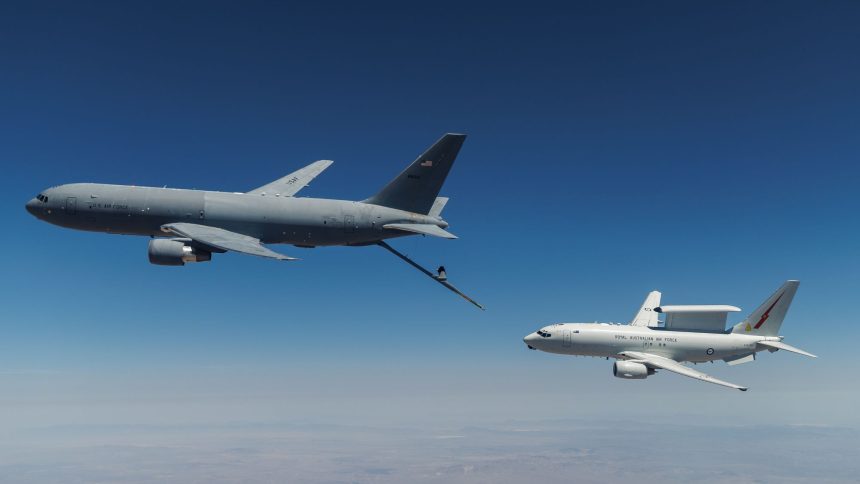The three nations certified the KC-46 to refuel the RAAF E-7, and USAF and RAF also benefit from this as they prepare to field their own Wedgetails.
The U.S., British and Australian air forces achieved a significant milestone by certifying the U.S. Air Force’s KC-46A Pegasus to refuel the RAAF (Royal Australian Air Force) E-7A Wedgetail AEW&C (Airborne Early Warning and Control) aircraft. The test campaign was conducted in the reserved airspace near Edwards AFB, California, and the Mojave desert.
An Apr. 28, 2025 statement from the 412th Test Wing, which led the effort, said that the collaboration rapidly improves “global combat capability while gathering critical test data for future acquisition of the E-7A Wedgetail.” The statement and the photos’ captions did not mention when the testing took place.
NEWS: 418th FLTS at Edwards executes historic trilateral test with @AusAirForce @RoyalAirForce. #RAAF E-7A now compatible with @usairforce KC-46, future test teams gain early knowledge ahead of anticipated E-7 fielding.
More- https://t.co/qvtPRzHxK3@HQ_AFMC @AFLCMCofficial pic.twitter.com/sMasEilJdB
— Edwards Air Force Base (@EdwardsAFB) April 28, 2025
However, the VIRIN (Visual Information Record Identification Number) name assigned to the photos indicates that the photos released were taken on Apr. 9, 2025. Also, aviation photographer TaskForce23 captured a photo of the E-7 in pre-contact position behind the KC-46 on Apr. 4.
Clearing the KC-46 to refuel E-7s?
flic.kr/p/2qX4L4h
[image or embed]
— TaskForce23 (@taskforce23.bsky.social) 11 aprile 2025 alle ore 17:47
Also, ADS-B tracking showed on Apr. 25, 2025 the same RAAF E-7A Wedgetail involved in the testing, serial A30-001, leaving Honolulu, Hawaii, and landing at Nellis AFB, Nevada. It is unclear if the aircraft returned to Australia after a first round of testing and later went back to the USA for the final certification tests.
“This milestone certifies KC-46A Pegasus air-to-air refueling of the RAAF’s E-7A Wedgetail, while streamlining USAF and RAF E-7 Wedgetail certification efforts,” said the press release. “The efforts are part of a broader vision of trilateral collaboration that identifies enhanced operational output through mutual support, shared resources, and commonality, ultimately achieving greater operational reliability through efficiencies of scale.”
While cementing the interoperability between the two aircraft, the certification also lent critical experience to future E-7A users United States and United Kingdom to rapidly operationalize their Wedgetails. In fact, the images’ descriptions said the trilateral enabled the United Kingdom and United States “to gain early test experience ahead of their anticipated fielding of E-7 aircraft variants.”
A beautiful shot of KC-46 refueling a E-7A Wedgetail from last week as part of trilateral test flights between the United States, United Kingdom, and Australia.🤘😎 pic.twitter.com/UeXePQJaVU
— Tim Farmer (@timfarmer) April 29, 2025
Additionally, the testing helped generate data from the KC-46A to expand capability to refuel future aircraft, as well as broadening the RAAF E-7’s options to be refueled by other tankers. The latter reason is even more important for the UK, as the RAF Voyager fleet is only equipped to perform hose and drogue refueling, while the E-7 is equipped to be refueled with the boom, meaning the UK would have to rely on allies to refuel its Wedgetails.
Am told RAF DOES plan to use allied boom-equipped tankers for E-7s. Gets better than that though – also intent to return AAR to MPA force, with RAF P-8 fuel system now being assessed for regular boom contacts. Never AAR requirement for C-17, while Voyager not equipped to receive. https://t.co/59KhSY3RVH
— Gareth Jennings (@GarethJennings3) April 30, 2025
E-7A Wedgetail
The Wedgetail, based on the Boeing B737NG airliner, is the next stage in U.S. Air Force’s and Allies’ AEW&C fleets. The aircraft is already operated by the RAAF, Republic of Korea Air Force and Turkish Air Force (TuRAF), with the U.S. Air Force, Royal Air Force and NATO preparing to field it.
The U.S. Air Force’s first rapidly prototyped unit is being constructed at Boeing’s facility in Renton, Washington. The aircraft will replace the aging fleet of 16 remaining E-3 airframes with 26 E-7 units.
The first of three of the RAF E-7A, designated the Wedgetail AEW1, completed its first test flight on Sept. 20, 2024 following conversion at Birmingham International Airport. It will replace the older E-3 Sentry AWACS (Airborne Warning and Control System), which flew its last mission in Aug. 2021.
NATO also selected the E-7 in 2023 to supplant its own inventory of 14 E-3s with six new aircraft. The fleet is expected to be based at Geilenkirchen airbase in Germany, where the E-3 fleet is based, with first aircraft expected to be delivered by 2031.
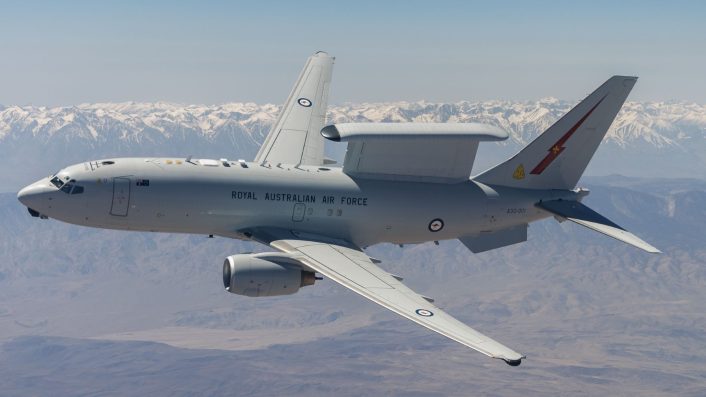
The RAAF is the type’s first operator and currently flies a fleet of six E-7A Wedgetails, with the last airframe delivered in June 2012. The aircraft are assigned to No.2 Squadron at RAAF Base Williamtown.
“We have already tested and overcome many early challenges typical of a new platform,” said RAAF Squadron Leader Owen Hamilton, flight commander, Aircraft Research and Development Unit. “This unique knowledge allows us to guide our allies in the U.K. and U.S. to field their own E-7A Wedgetail capability faster.”
The vast Australian experience is therefore helping guide the U.S. and U.K. who are yet to receive their Wedgetails, while aiding its own capability expansion. The experience gained through the trilateral agreement will certainly be transferred to NATO too.
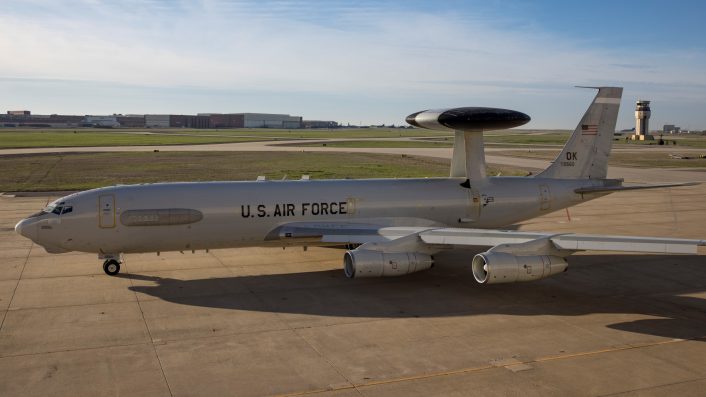
The E-7 Wedgetail was initially developed for the RAAF under “Project Wedgetail.” The service envisions the E-7A, along with its MC-55A Peregrine EW/SIGINT (Electronic Warfare/Signals Intelligence) aircraft, E/A-18G Growler electronic attack jets and F-35A Lightning IIs as a part of a combined airborne network offering diverse electromagnetic capabilities – radar, electronic, communications, signals surveillance and jamming.
The E-7 is obtained by conversion from the commercial Boeing 737-700, capitalizing on the existing aircraft design, certification and modification processes which, together with a well-established supply chain, will reduce development, maintenance and logistics costs as well as the time needed before it can be fielded.
Boeing says the E-7 provides a fully integrated, combat-proven, flexible command and control node that delivers multi-domain awareness in the most challenging operational environments. The E-7’s open systems architecture and agile software design enable the aircraft’s capabilities to evolve and remain ahead of future threats.
Northrop Grumman is the developer of the Multi-role Electronically Scanned Array (MESA) radar located on a dorsal fin on top of the E-7’s fuselage, which provides 360-degree surveillance capability (although it doesn’t rotate like the E-3 Sentry’s antenna) with both air-to-air and air-to-surface coverage with and integrated Identification Friend or Foe system. MESA provides the warfighter with critical domain awareness to detect and identify adversarial targets at long range and dynamically adjusts to emerging tactical situations, said the press release.
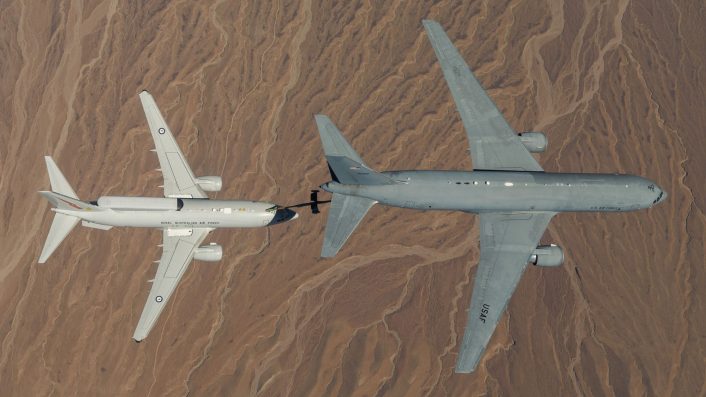
Allied E-7A Wedgetail programs and the KC-46A Pegasus
The current round of testing certifies the E-7A Wedgetail to be refueled by the KC-46A Pegasus. This certification is intended to be in place by the time the U.S. Air Force receives its first E-7A from Boeing, currently expected in 2027, shortening the time required to field the new aircraft operationally.
The USAF’s E-7s are different from the RAAF’s and RAF’s Wedgetails, and thus require a separate set of engineering work. With timing being critical to avoid dangerous capability gaps, the work done with the RAAF’s E-7s would help identify any issues, including E-7/KC-46 refueling compatibility issues, before the U.S. receives its first rapidly prototyped AEW&C aircraft.
The first E-7A entered the assembly phase following a Aug. 9, 2024 $2.56 billion contract to Boeing to rapidly prototype two aircraft, continuing the work of the E-7A Rapid Prototype program that the service started in 2023. The aircraft recently saw the fuselage being mated to the wings and will soon receive horizontal and vertical stabilizers.
The latest round of tests led by the Global Reach Combined Task Force, along with the 418th FTS, also marked the KC-46A Pegasus’ “first aerial refueling receiver certification for a unique foreign aircraft type,” mentioned the Air Force. At the same time, the RAAF’s E-7s increase their combat reach with new “options beyond the traditional KC-135 Stratotanker and RAAF KC-30A Multi-Role Tanker Transport,” the statement added.
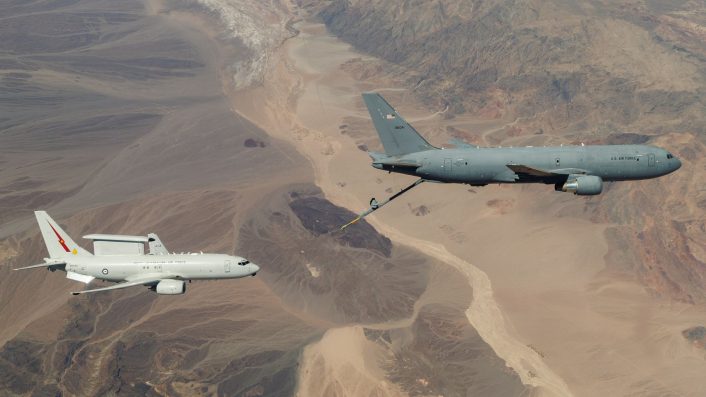
Collaboration and challenges
The press release noted how the KC-46A/E-7A compatibility “will immediately benefit the Pacific theater,” while also paying “dividends” to future E-7 operators, the USAF and the RAF, in the coming years.
As mentioned earlier, the RAAF is the original operator of the E-7A, and the service has “already tested and overcome many early challenges typical of a new platform,” said Squadron Leader Owen Hamilton. This experience knowledge is being used by the RAAF to the advantage of its allies in the U.K. and U.S., helping them “to field their own E-7A Wedgetail capability faster.”
However, there are still some challenges, including “understanding the required processes for secure data sharing between the KC-46 and E-7A,” said the press release, as the two aircraft have never interfaced before. Boeing and the KC-46 program office assisted the 418th FLTS with this issue.
“Sharing data and understanding how to dissect and utilize the information is just as important as the actual test certification,” said Maj. Matthew Daughtery, global reach test pilot, 418th FLTS. “There are no benchmarks or precedents for aligning these systems. The USAF and RAAF use different rules and nomenclatures. A key part of developmental testing is to find a path to success. Where there’s a will, there’s a way!”
As part of the trilateral agreement, a RAF representative took part in the activities. “We will soon begin flight testing our own E-7A aircraft, and this early collaboration will help us field our capability more efficiently,” said Squadron Leader Angus Lilly, RAF test pilot.
The USAF press release further stressed how “the robust testing over the Mojave Desert signals a new era in networked airborne early warning and control capability,” and the “lessons learned are already informing future test planning as the RAF and USAF prepare to transition to E-7 Wedgetail operations.”
Additionally, the test campaign generated “a data baseline” for the KC-46A Pegasus to be used “for certifying unique foreign aircraft,” the release added. Michael Baker, E-7A chief of development test for the USAF that this “also lays a path for future cooperation to enhance the E-7A for the future.”
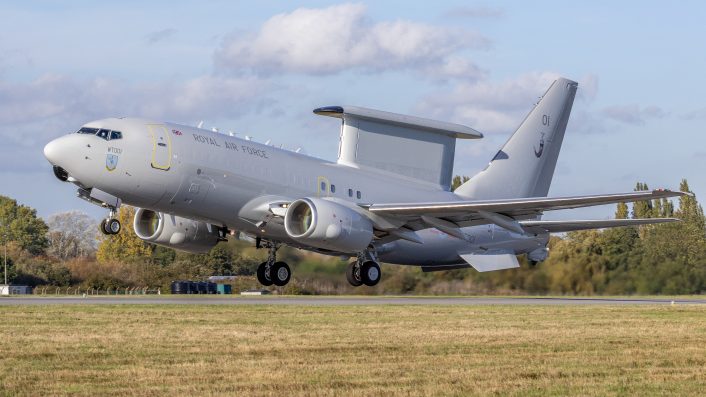
KC-46A Pegasus issues
As reported by The Aviationist, the KC-46A Pegasus program is beset by a series of technical and design flaws, some of which classified as “Category 1” deficiencies which endanger both the aircraft and the crew. March saw the USAF pausing additional deliveries of the tanker and a fleet-wide inspection of its 89 aircraft after cracks were discovered in the ‘outboard fixed-trailing-edge support structure’ of two planes, which were set to be handed over.
Meant to replace the older KC-135 Stratotankers, the KC-46s also suffered issues with its ARS (Automatic Refueling System), among others. The two groups of cameras, including the RVS (Remote Vision System) which focus on the boom and the second which provides a panoramic rear view of the tanker, struggle under certain environmental conditions.
Another problem is related to the boom, and specifically an actuator inside the boom which prevents the A-10C to be refueled. In fact, the A-10 can’t generate enough force to stay connected to the boom due to its low speed, so the hydraulic actuator provides that force to keep the boom rod in the receptacle. A new actuator is expected by 2026.
Improperly placed couplings in the fuel lines and an issue with the AAR receptacle on top of the cockpit also risked fuel leaks inside the aircraft and the cockpit.

